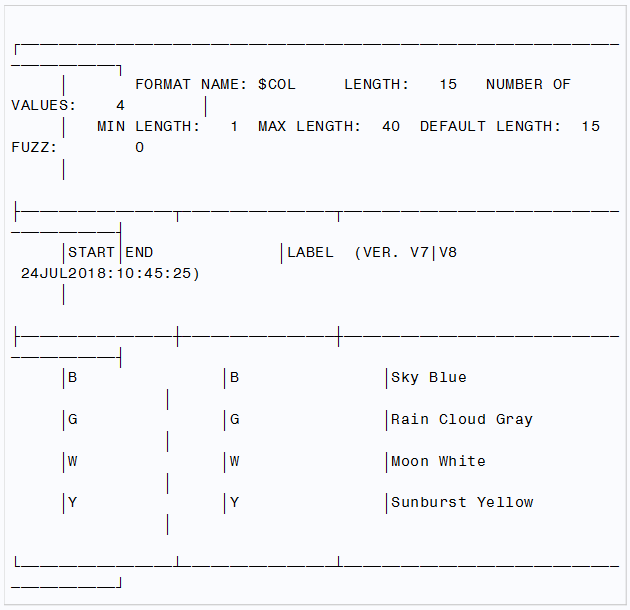Associating User-Defined Formats with Variables
How SAS Finds Format Catalogs
To use the GENDER, AGEGROUP,
and $COL formats in a subsequent SAS session, you must assign the
libref Formtlib again.
libname formtlib 'C:UsersStudent1formatslib';
SAS searches for the
formats GENDER, AGEGROUP, and $COL in two libraries, in this order:
-
the temporary library referenced by the libref Work
-
a permanent library referenced by the libref Formtlib
SAS uses the first instance
of a specified format that it finds.
Tip
You can delete formats using
PROC CATALOG.
Assigning Formats to Variables
Just
as with SAS formats, you associate a user-defined format with a variable
in a FORMAT statement.
data work.carsurvey;
set cert.cars;
format Sex gender. Age agegroup. Color $col. Income Dollar8.;
run;
Remember, you can place
the FORMAT statement in either a DATA step or a PROC step. By placing
the FORMAT statement in a DATA step, you permanently associate a format
with a variable. Note that you do not have to specify a width value
when using a user-defined format.
When you submit the
PRINT procedure, the output for Work.CarSurvey now shows descriptive
labels instead of the values for Age, Sex, Income, and Color.
proc print data=work.carsurvey; run;
Output 12.1 Work.CarSuvery Data Set with Formatted Values

When associating a format
with a variable, remember to do the following:
-
Use the same format name in the FORMAT statement that you specified in the VALUE statement.
-
Place a period at the end of the format name when it is used in the FORMAT statement.
If you do not format
all of a variable's values, then those that are not listed in
the VALUE statement are printed as they appear in the SAS data set.
In the example below, the value of 2 was not defined in the VALUE
statement for GENDER as shown in observation 3, 5, 7, and 8.
libname formtlib 'C:UsersStudent1formatslib'; proc format lib=formtlib; value gender 1 = 'Male'; value agegroup 13 -< 20 = 'Teen' 20 -< 65 = 'Adult' 65 - HIGH = 'Senior'; value $col 'W' = 'Moon White' 'B' = 'Sky Blue' 'Y' = 'Sunburst Yellow' 'G' = 'Rain Cloud Gray'; run; data work.carsurvey; set cert.cars; format Sex gender. Age agegroup.Color $col. Income Dollar8.; run; proc print data=work.carsurvey; run;
Output 12.2 Work.Carsurvey Data Set with Missing Formatted Values

Displaying User-Defined Formats
When you build a large catalog of
permanent formats, it can be easy to forget the exact spelling of
a specific format name or its range of values. Adding the keyword
FMTLIB to the PROC FORMAT statement displays a list of all the formats
in your catalog, along with descriptions of their values.
libname formtlib 'c:sasformatslib';
proc format library=formtlib fmtlib;
run;When you submit this
PROC step, a description of each format in your permanent catalog
is displayed as output.
Output 12.3 Output of the Formtlib Catalog



In addition to the name,
range, and label, the format description includes the following details:
-
length of the longest label
-
number of values defined by this format
-
version of SAS that was used to create the format
-
date and time of creation
Last updated: August 23, 2018
..................Content has been hidden....................
You can't read the all page of ebook, please click here login for view all page.
